Moran Katz.
CORAL GABLES —The Carnegie Hall chamber music collective known as Decoda has developed a continuing relationship with the Mainly Mozart Festival, and on Sunday, two of the group’s members joined festival director Marina Radiushina for a strong program of works featuring the clarinet and cello.
On hand for the last concert before the festival’s finale Friday night at the Knight Concert Hall in Miami’s Arsht Center were clarinetist Moran Katz and cellist Caitlin Sullivan. In addition to two major works with the piano, the two young women were heard in solo and duet pieces that added some interesting variety to a program bookended by substantial sonata-form compositions.
The concert at the Coral Gables Congregational Church, across the way from the Biltmore Hotel where most of the Mainly Mozart concerts have taken place, opened with the so-called Kegelstatt Trio of Mozart (in E-flat, K. 498), originally for clarinet, viola and piano, with Sullivan taking the viola part on her cello.
Something about the clarinet drew engaging melodies out of Mozart, and this trio, although it’s not as well-known as the concerto or quintet, is a fine example. Katz, an Israeli-born musician, has a very large, powerful tone that extends all the way into the highest registers. She never squeaks or gets pinched, just keeps rolling out yard after yard of round, confident sound. It’s playing with real presence, and it goes well with her bubbly stage personality.
She was ably joined by Radiushina, an excellent pianist, and Sullivan, who handled all the skittish accompaniment figures in the viola part with polish, accuracy and verve. The three women gave an elegant reading of this trio, with warmth and good spirits in the outer movements and much the same in the middle minuet, though some more contrast would have been welcome there, with a little more dynamic variety in the minuet and more mystery in the trio.
Caitlin Sullivan.
Two solos and a duet followed, begin with one of the most famous of all cello miniatures, Camille Saint-Saëns’ “The Swan,” from his 1886 “zoological fantasy,” Carnival of the Animals. Sullivan played this with tenderness, restraint and stellar intonation. Her sound is focused and intense, and very well-suited to French music of this era. She managed to make this well-worn near-salon piece sound simply beautiful just by playing it honestly and not trying to oversell it; she let this suave late Romantic melody speak for itself, and was rewarded with a hushed audience that hung on every note.
Katz was next in a performance of Astor Piazzolla’s popular tango Oblivion. She performed it like an ad-libbing klezmer musician, improvising the second time through the melody with smears and bends, following a completely different trajectory than the composer. One senses that he would have approved; it was a nice, refreshing take on a piece that gets treated all too seriously when it’s pulled out for encores, which is fairly frequent these days.
If the Piazzolla whetted the appetite to hear Katz in jazz, the duet for clarinet and cello that came next, Guillaume Connesson’s Disco Toccata, gave the audience a good example of what that would be like. Connesson’s clever piece has nothing to do with disco; it’s more like a 1920s Martinů shimmy than anything else. But it’s great fun anyway, with its catchy rhythms and its cheeky style. It sounds quite difficult, too, but Katz and Sullivan played it marvelously well, drawing a whoop of pleasure from the audience.
The second half was given over to the Clarinet Trio (in A minor, Op. 114) of Johannes Brahms, one of the late works he composed for the Meiningen clarinetist Richard Mühlfeld toward the end of his life. Like the Kegelstatt, this work is nowhere near as well-known as Brahms’s Clarinet Quintet, but it is a work of severe and rare beauty, and it was a great treat to hear it played Sunday afternoon.
Marina Radiushina.
Much in evidence were the traits mentioned earlier: Katz’s ability to soar and not honk in the upper reaches of the instrument, Sullivan’s noble tone and pinpoint accuracy, and Radiushina’s impressive command of her instrument. Of particular note here were the subtler touches such as the beautiful close of the first movement, with its fading arpeggios in clarinet and cello, and the second movement as a whole, where the three women were as one in digging into this radiant, gorgeous music.
Brahms’s autumnal grace was lovingly realized in the third movement, which the musicians brought out with exceptional delicacy. The finale, expertly played as it was, lacked energy, and came out as something of an anticlimax. The movement has to break with the green glades of the previous two movements and find something primal in the mud in order to work well, but here it was somewhat too matter-of-fact.
Nonetheless, this was overall a wonderful performance of a too little-known masterwork, and it introduced area audiences to two fine guest musicians that we would welcome back with open arms. This kind of quality in chamber music programming and performing is what we go to Mainly Mozart for, and it’s good to see it continuing to offer standout programs as the long, hot summer gets underway.
The Mainly Mozart Festival closes Friday night at the Knight Concert Hall in Miami’s Adrienne Arsht Center for the Arts, 1400 Biscayne Blvd. Soprano Chen Reiss will sing arias by Mozart, along with a world premiere of a new dance work by the Miami City Ballet’s Adriana Pierce set to music by Pärt, Saint-Saëns and others, under the theme of Timeless Rose. The concert starts at 8 p.m. Tickets are $30; visit arshtcenter.org or call the box office at 305-949-6722.


